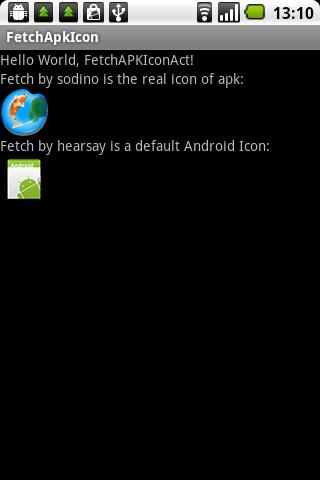网上关于"获取未安装的APK图标"的文章满天飞,但都是转帖,运行后的效果却是获取到Android的默认小机器人图标.那个暴寒....
现提供解决方法如下,废话不说,上效果图,见代码:

本方法需要使用到Java反射的知识,具体请参考:
http://java.sun.com/developer/technicalArticles/ALT/Reflection/index.html
借鉴的Android源码出处:
package lab.sodino.fetchapkicon; import java.io.File; import java.lang.reflect.Constructor; import java.lang.reflect.Field; import java.lang.reflect.Method; import android.app.Activity; import android.content.Context; import android.content.pm.ApplicationInfo; import android.content.pm.PackageInfo; import android.content.pm.PackageManager; import android.content.res.Resources; import android.graphics.drawable.Drawable; import android.os.Bundle; import android.util.DisplayMetrics; import android.util.Log; import android.view.View; import android.widget.ImageView; /** * @author Sodino sodinoopen@hotmail.com * @since 2011年3月1日13时00分41秒 * */ public class FetchAPKIconAct extends Activity { public void onCreate(Bundle savedInstanceState) { super.onCreate(savedInstanceState); setContentView(R.layout.main); showUninstallAPKIcon("/sdcard/APK/JarodYv.FishPool.apk"); getUninatllApkInfo(this, "/sdcard/APK/JarodYv.FishPool.apk"); } /** 网传的方法,但获取不成功 */ public void getUninatllApkInfo(Context context, String archiveFilePath) { PackageManager pm = context.getPackageManager(); PackageInfo info = pm.getPackageArchiveInfo(archiveFilePath, PackageManager.GET_ACTIVITIES); if (info != null) { ApplicationInfo appInfo = info.applicationInfo; Drawable icon = pm.getApplicationIcon(appInfo); ImageView image = (ImageView) findViewById(R.id.apkIconByTradition); image.setVisibility(View.VISIBLE); image.setImageDrawable(icon); } } // private void showUninstallAPKIcon(String apkPath) { String PATH_PackageParser = "android.content.pm.PackageParser"; String PATH_AssetManager = "android.content.res.AssetManager"; try { // apk包的文件路径 // 这是一个Package 解释器, 是隐藏的 // 构造函数的参数只有一个, apk文件的路径 // PackageParser packageParser = new PackageParser(apkPath); Class pkgParserCls = Class.forName(PATH_PackageParser); Class[] typeArgs = new Class[1]; typeArgs[0] = String.class; Constructor pkgParserCt = pkgParserCls.getConstructor(typeArgs); Object[] valueArgs = new Object[1]; valueArgs[0] = apkPath; Object pkgParser = pkgParserCt.newInstance(valueArgs); Log.d("ANDROID_LAB", "pkgParser:" + pkgParser.toString()); // 这个是与显示有关的, 里面涉及到一些像素显示等等, 我们使用默认的情况 DisplayMetrics metrics = new DisplayMetrics(); metrics.setToDefaults(); // PackageParser.Package mPkgInfo = packageParser.parsePackage(new // File(apkPath), apkPath, // metrics, 0); typeArgs = new Class[4]; typeArgs[0] = File.class; typeArgs[1] = String.class; typeArgs[2] = DisplayMetrics.class; typeArgs[3] = Integer.TYPE; Method pkgParser_parsePackageMtd = pkgParserCls.getDeclaredMethod("parsePackage", typeArgs); valueArgs = new Object[4]; valueArgs[0] = new File(apkPath); valueArgs[1] = apkPath; valueArgs[2] = metrics; valueArgs[3] = 0; Object pkgParserPkg = pkgParser_parsePackageMtd.invoke(pkgParser, valueArgs); // 应用程序信息包, 这个公开的, 不过有些函数, 变量没公开 // ApplicationInfo info = mPkgInfo.applicationInfo; Field appInfoFld = pkgParserPkg.getClass().getDeclaredField("applicationInfo"); ApplicationInfo info = (ApplicationInfo) appInfoFld.get(pkgParserPkg); // uid 输出为"-1",原因是未安装,系统未分配其Uid。 Log.d("ANDROID_LAB", "pkg:" + info.packageName + " uid=" + info.uid); // Resources pRes = getResources(); // AssetManager assmgr = new AssetManager(); // assmgr.addAssetPath(apkPath); // Resources res = new Resources(assmgr, pRes.getDisplayMetrics(), // pRes.getConfiguration()); Class assetMagCls = Class.forName(PATH_AssetManager); Constructor assetMagCt = assetMagCls.getConstructor((Class[]) null); Object assetMag = assetMagCt.newInstance((Object[]) null); typeArgs = new Class[1]; typeArgs[0] = String.class; Method assetMag_addAssetPathMtd = assetMagCls.getDeclaredMethod("addAssetPath", typeArgs); valueArgs = new Object[1]; valueArgs[0] = apkPath; assetMag_addAssetPathMtd.invoke(assetMag, valueArgs); Resources res = getResources(); typeArgs = new Class[3]; typeArgs[0] = assetMag.getClass(); typeArgs[1] = res.getDisplayMetrics().getClass(); typeArgs[2] = res.getConfiguration().getClass(); Constructor resCt = Resources.class.getConstructor(typeArgs); valueArgs = new Object[3]; valueArgs[0] = assetMag; valueArgs[1] = res.getDisplayMetrics(); valueArgs[2] = res.getConfiguration(); res = (Resources) resCt.newInstance(valueArgs); CharSequence label = null; if (info.labelRes != 0) { label = res.getText(info.labelRes); } // if (label == null) { // label = (info.nonLocalizedLabel != null) ? info.nonLocalizedLabel // : info.packageName; // } Log.d("ANDROID_LAB", "label=" + label); // 这里就是读取一个apk程序的图标 if (info.icon != 0) { Drawable icon = res.getDrawable(info.icon); ImageView image = (ImageView) findViewById(R.id.apkIconBySodino); image.setVisibility(View.VISIBLE); image.setImageDrawable(icon); } } catch (Exception e) { e.printStackTrace(); } } }
本文内容归CSDN博客博主Sodino 所有
转载请注明出处: http://blog.csdn.net/sodino/archive/2011/03/01/6215224.aspx
























 1万+
1万+

 被折叠的 条评论
为什么被折叠?
被折叠的 条评论
为什么被折叠?








